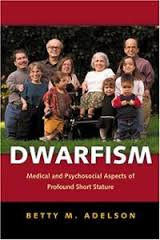Betty Adelson
Author of "The Lives of Dwarfs" and "Dwarfism"
My own journey toward understanding, which led eventually to my researching and publishing two books about the lives of the very short, stigmatized people known as dwarfs, began in 1974 when my daughter Anna was born with achondroplasia, the most common type of dwarfism (Adelson 2005). My decision to write a cultural history of dwarfism was influenced by the fact that in the early years after her birth, when I searched the literature for works about dwarfs, the books I found had titles such as Freaks, Victorian Grotesque, and Human Oddities—most often written by onlookers from an alienated perspective. A standard medical text I came upon asserted that because of their grotesque appearance and strength, achondroplastic dwarfs were apt to be employed in the circus; the author described these individuals as immature, with strong feelings of inferiority, often vain and fond of drink, and sometimes lascivious (Durthee & Bentley, 1983). Although stereotypes such as this still persist, a number of high-quality works have appeared since (see Ablon 1984, 1988; Dasen 1993).
This landmark volume is the first to trace the exciting developments in the field of dwarfism research and treatment over the past century—particularly during the past fifty years. Dr. Betty M. Adelson, a psychologist, has unearthed and synthesized the most significant information about dwarfing conditions, from articles written a century ago to current books and specialized databases. Highlighting the outstanding contributions of Dr. Victor McKusick and several of his colleagues, Dr. Adelson reveals how dwarfism specialists have helped redefine the nature of medical care—transforming it from an authoritarian enterprise into a holistic, collaborative venture among physicians, affected individuals, and their families. The parent of an adult dwarf daughter, Adelson examines the social forces that affect the dwarfism community. She offers personal descriptions of the day-to-day challenges dwarf individuals face and portrays their accomplishments. Insightful and accessible, this work will prove a valuable resource for affected individuals, their families, and medical professionals—physicians, nurses, genetic counselors, social workers, psychologists, and medical students.
"The Lives of Dwarfs is extraordinary in its range and vision. Beautifully written. Totally absorbing."—Ursula Hegi, author of Stones from the River
"As a little person, husband, and father of a little person, I dream of the day when dwarfs attain full acceptance in society. The Lives of Dwarfs provides a giant step in that direction."—Rick Spiegel, former president of Little People of America
"This important book makes it possible for both average- and short-statured people to challenge our collective understanding of dwarfism as a synonym for diminishment or as an array of cute and evil fairy-tale figures. The libratory work of this book is to invite us all to reimagine dwarfism as a livable experience and tenable way of being in the world."—Rosemarie Garland Thomson, author of Extraordinary Bodies: Figuring Physical Disability in American Culture and Literature
"A work of compassionate scholarship. A unique contribution to the literature of physical deformity and social isolation and a gift to the individuals whose personal struggle this is."—Linda Hunt, actor
Historically, they have borne the labels "freaks" and "oddities"; they have been collected as pets, displayed as spectacles, and treated as comic relief. Now, for the first time, in this elegant and comprehensive volume, the lives of dwarfs are explored in all their fullness and humanity.
Spanning the centuries from ancient Egypt to the present, this unique social history chronicles the various ways this population has been exploited, describes their strategies for coping, and notes the persistent influence of mythology upon perceptions of them by others. The narrative also highlights the lives of eminent individuals and contains a thought-provoking account of the representation and participation of dwarfs in the arts, enhanced by outstanding color photographs. Betty M. Adelson, the mother of a daughter with dwarfism, brings special insight and sensitivity to the research. She traces the widespread mistreatment of dwarfs over the centuries, engendered by their being viewed as curiosities rather than as human beings capable of the same accomplishments as people of average height, and deserving of the same pleasures. For much of their history, dwarfs have resorted to exhibiting themselves: because of social stigma no other employment was available.
Only in recent years have short-statured individuals begun to challenge their position in society. Medical advances, new economic opportunities, and disability legislation have led to progress, mainly in Western nations. Advocacy groups have also formed in countries as diverse as Chile, South Korea, and Nigeria. Adelson compares what she refers to as the "small revolution" to similar social and cultural awakenings that women, African Americans, gays and lesbians, and persons with disabilities experienced when they identified themselves as a community with shared goals and obstacles.
Written with passion, grace, and the dignity that the subject deserves, The Lives of Dwarfs will not only revolutionize current perceptions about the historically misrepresented dwarf population, but also offer pause for thought on issues of disability, medical treatment, height, beauty, and identity.




